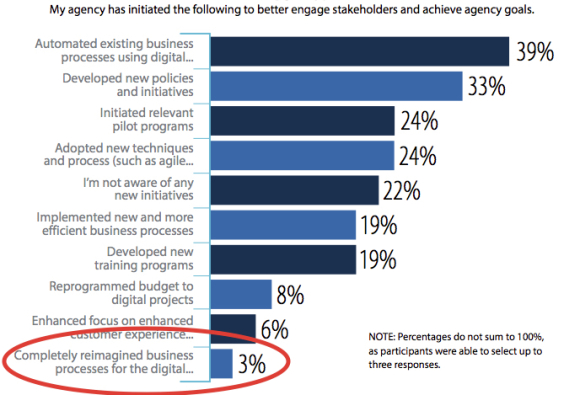

Ride-sharing is just one example of how digital tech can transform a service. Where are those examples in government?
This column was originally published on Jeff Neal’s blog, ChiefHRO.com and was republished here with permission from the author.
Uber, Lyft and other ride-sharing services completely reimagined the concept of a car for hire. Compare the taxi experience to Uber.
Rather than standing on a street corner and hailing a random cab, or calling for a cab and waiting for whoever is dispatched to arrive, the customer uses a smartphone app, gets to see the driver’s name, photo, car make and model, and license plate number, where the car is on a real-time map, and driver reviews.
The Uber app allows fare sharing. The difference is a far more customer-focused approach to the car hiring process, all enabled by digital technology. That’s not saying Uber or Lyft are perfect. There are issues with the variable demand-based pricing and labor issues regarding the status of drivers as contractors rather than employees. Issues aside, this type of ride-sharing business is booming and customers who use them frequently like them.
Ride-sharing is just one example of how digital tech can transform a service. Where are those examples in government? The U.S. Digital Service provides some examples and is promoting the idea of “redefining the experience of government.”
The Obama Administration has directed agencies to stand up digital services units, and it is clear that there is a substantial interest in more and better use of digital technology.
The National Academy of Public Administration (NAPA) and ICF International (ICF) recently released the results of the Federal Leaders Digital Insight Study (FLDIS). The annual study looks at “the extent to which the federal government was adopting and applying digital technology to serve stakeholders.” The Study found that “… while federal agencies are making progress meeting the public’s rising expectations of digital adoption, the accelerating pace of technological change causes concern that the government will continually lag behind the private sector.”
There are many reasons why the federal government lags behind the most digitally progressive companies, not the least of which are the political environment, the budget process, the short-term focus of some political appointees, and an acquisition process that is not always attuned to the digital market.
Despite those hindrances, some agencies are doing great work using digital technology. The Census Bureau and U.S. Citizenship and Immigration Service are just two of the examples the study cited. In recent years the Office of Management and Budget has released the U.S. Digital Services Playbook, “… a playbook of 13 key ‘plays’ drawn from successful practices from the private sector and government that, if followed together, will help government build effective digital services.”
They also published the TechFAR, which “… highlights the flexibilities in the Federal Acquisition Regulation (FAR) that can help agencies implement ‘plays’ from the Digital Services Playbook that would be accomplished with acquisition support — with a particular focus on how to use contractors to support an iterative, customer-driven software development process, as is routinely done in the private sector.”
The Playbook and TechFAR clearly demonstrate that effective digital services do not require new laws or regulations — they require agency leadership, digital services, acquisition and program teams that look beyond paper processes, outdated technology and the inertia that keeps them on the same course, to re-imagine government services the way they can be, rather than the way they are.

Among the findings of the FLDIS, one that stood out like a sore thumb is this: Only 3 percent of respondents said their agencies completely re-imagined business processes for the digital environment. Only 6 percent said their agencies focused on enhancing the customer experience. Automating paper processes was the number one answer at 39 percent.
There is nothing wrong with incremental improvement. Some of the best companies in the world continually update and improve products, services and processes in a way that lead to substantial long-term improvement. However, where we can we should seek to produce the kind of disruptive beneficial change that digital technology enables.
The federal government is one of the largest consumers of tech on the planet, yet it typically resists radical change and the rewards that can come with it. If we want to redefine the experience of government, we have to be willing to completely re-imagine how government processes work.
I believe there are a lot of talented people in government and industry who can make the kind of big leaps that are needed. If we are willing to take the risk, we can deliver “wow” moments for the American people. Those “wow” moments will lead to more respect for and trust in government and the people in it, and they will produce the kind of world-class services the people deserve.
Jeff Neal is a senior vice president for ICF International and founder of the blog, ChiefHRO.com. Before coming to ICF, Neal was the chief human capital officer at the Department of Homeland Security and the chief human resources officer at the Defense Logistics Agency
Copyright © 2025 Federal News Network. All rights reserved. This website is not intended for users located within the European Economic Area.



